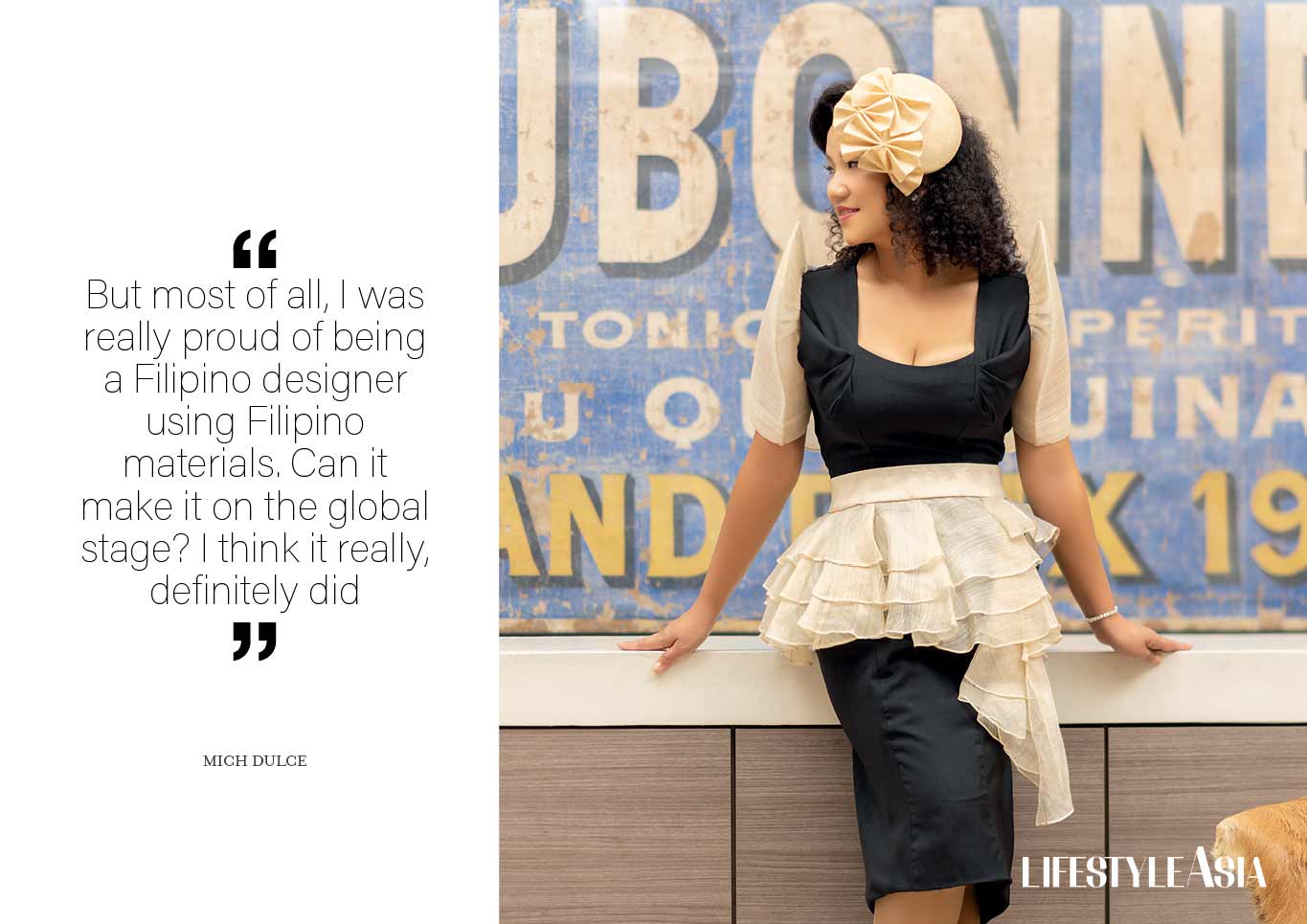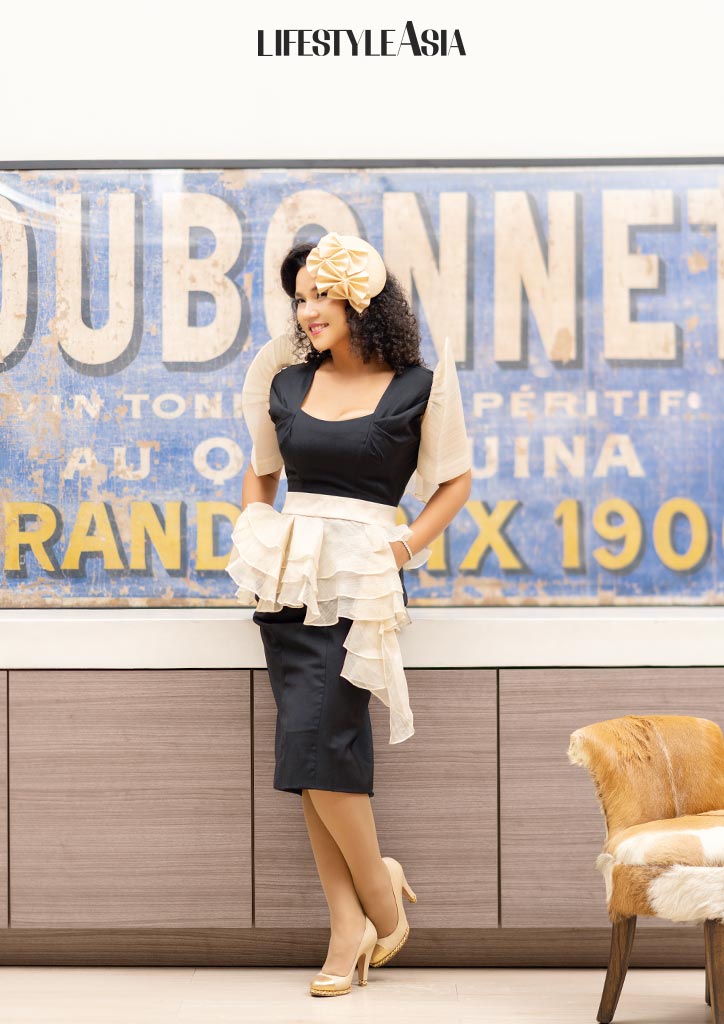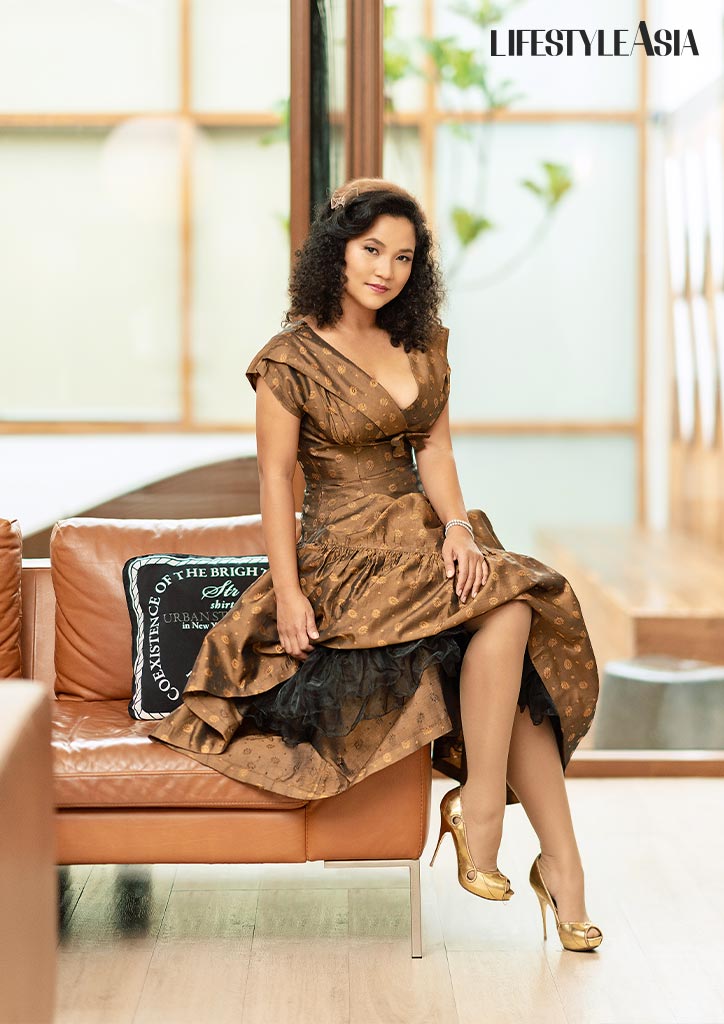Fittingly enough, award-winning milliner Mich Dulce wears many hats.
Fashion designer, artistic director, musician, chief executive officer, consultant, feminist, artist—to name a few.
Her expertise outside of fashion lies in supply development and women’s economic empowerment. This multiperspective lens has informed Dulce’s work throughout the years, allowing her to transcend the boundaries of sartorial into the realm of original.
The designer’s creations have graced all the world’s fashion capitals and economic centers in the decade since her label was first sold globally in 2009 and she was named the British Council’s 2010 International Young Fashion Entrepreneur of the Year.
The likes of Anna Dello Russo, Celine Dion, and Lady Gaga have all worn “Mich Dulce.” By now, the challenge for her is no longer to establish her brand, the Filipino brand.
For Dulce, rather, it’s high time to embrace a forward-looking fashion process that sews together style and sustainability.
Inclusivity is in season.

Fashion-forward
“The biggest obstacle is really like keeping yourself in check,” Dulce tells Lifestyle Asia.
As the owner of her brand, she admitted that she also had to check herself. This was to ensure that her business practices corresponded to her ideals.
“Being a feminist and learning about the structural inequalities that exist within our capitalist society, it helps me to think about my brand in terms of sustainability,” Dulce situates.
“Aside from zero-waste practices and environmental issues, there’s so much to consider: the fair compensation of everyone in the supply chain, their welfare and working environment…makes you question if you are really enriching the lives of your suppliers by just buying the product they sell you.”
“Taking all that into consideration and trying to improve systems is a difficult thing. I can’t say at all that I’m perfect, or that I am getting everything I want done,” Dulce admits.
In her early years, the designer used to be so “obsessed” with doing ready-to-wear, because it seemed like the only sales model that would make allow for a global market presence. But with sustainability in mind, she resolved to move the direction of her brand into made-to-order.

“So going back to that model of only making what we need and what people are going to purchase. And this was because I realized that in the Philippines, when we work with craft and when we use our own materials—it’s handmade, it’s handwoven,” Dulce explains.
She gave as example how Filipinos would extract the fibers from piña, retrieve abaca from the banana plant, and pound everything by hand.
“It’s been ‘slow fashion.’ Without conceiving the term years and years ago, working with your hands is slow fashion,” Dulce expounds.
The designer found this transition necessary because in times of calamity and crisis, her brand would be left with shortages of piña, abaca, and other necessary materials. For her, it was about respecting the timeframe and slowness of the craft in response to the circumstances.
“Because everything is so fast with fashion, there’s so many freaking fashion seasons in a year. From couture to spring/summer, pre-collections, autumn/winter. The system is so fast. If you go back to the Philippines, the made-to-measure system, handmade… it’s a slow fashion movement. I think that we can learn from that,” Dulce suggests.
This translates to learning how to go back to artisanal, where the Philippines finds its roots.
Hat tip
As for how Filipinos will stand on the global stage, the milliner finds her past experiences are a good indicator.
While studying hatmaking at Central Saint Martins in London, she observed that a lot of the materials used in the trade, particularly sinamay, came from the Philippines.
“From that point, I was kind of like intrigued. That’s so bizarre, right? At that time, there was no kind of globally famous Filipino milliner, there’s no Filipino person who was like, ‘Okay, I’ll make hats.’ When most of the straw used for making hats comes from the Philippines,” Dulce observes.
This became her personal entry point into researching and looking for ways to utilize Filipino materials in her craft.

She traced how at the time, it wasn’t so common for designers to use local materials. Rather, everyone aspired to be international designers by using fabrics from other countries.
“The landscape has totally changed. Now you see so many Filipino designers embracing our own. I think that I had a turning point in my career when I decided to do that,” Dulce analyzes.
For instance, she incorporated T’nalak, a traditional cloth handwoven by the T’boli people, in her creations.
“Immediately, I got really good feedback for it being ethical, because my business is run as a social enterprise. It used natural materials. And also because of the heritage that my fabric has that is so different from the rest of the world. But most of all, I was really proud of being a Filipino designer using Filipino materials. Can it make it on the stage? I think it really, definitely did,” Dulce champions.
Made to measure
Her tip to aspiring or budding Filipino designers is to develop their own look or niche that sets them apart from the rest.
“Be fearless, but also keep yourself in check in terms of your values. Know what it is you really want for your brand. But be humble in knowing there’s so much that needs to be done,” Dulce advises.
Sustainability considers different factors like environmental, social, and capacity-building, according to the designer, who finished her graduate studies in social entrepreneurship at Goldsmiths, University of London.
“It’s a system of monitoring and evaluating the goals that you want to achieve…looking at all the different parts, choosing which to focus on first, but not just ticking boxes…it’s important to keep yourself in check as your business grows,” Dulce elaborates.
She added how even little steps to address sustainability go a long way.

Keeping all of these mind, the designer is about ready to conclude her hiatus.
“I’ve taken a break from international selling, because I wanted to fix my brand first before bringing it abroad. It’s kind of humbling to stop and start again,” Dulce opens.
She anticipates resuming her international fashion activities later this year, exploring the idea of going back to wholesale and ready-to-wear.
Dulce is currently working on Assemblage, her new retail format. Everything is made-to-order, rather than having seasonal collections. Every Assemblage brings together a curated mix of products, allowing her to remain consistently creative, revisit past pieces, utilize resources, and manufacture in the most sustainable way.
“I had to think about it a lot, because obviously it’s a completely different model. It’s to make sure that we give our artisans time to weave their fabrics, it helps us make sure that everything we have in stock is utilized, it allows us to be more creative…it allows us to make clothes with intent,” Dulce concludes.
For shopping and inquiries, visit MichDulce.com.
Photos PATRICK DIOKNO
Creative Direction PAOLO TORIO
Art Direction MARC YELLOW
Sittings Editor CANDY DIZON
Stylist (Mich) STEVEN CORALDE
Stylist (Cecile) MELVIN MOJICA
Makeup AL DE LEON AND OMAR ERMITA FROM MAC
Hair CATS DEL ROSARIO
Shoot Coordination MAE TALAID AND MJ ALMERO





